ACCY903: BHP Climate Change Disclosures Analysis Report (2016-2018)
VerifiedAdded on 2023/04/23
|12
|2385
|53
Report
AI Summary
This research report analyzes the climate change disclosures of BHP Billiton from 2016 to 2018, focusing on their corporate social responsibility and environmental strategies. The report begins with an introduction outlining the research objectives, research question, and a literature review on carbon business accounting and the role of carbon accounting in business, particularly in relation to BHP's efforts. The methodology employs a positivism research philosophy with an inductive approach, utilizing secondary data from various sources including journals, publications, and BHP's online presence. The findings reveal BHP's commitment to reducing carbon emissions through investments in renewable energy projects like the Lakeland Solar and Storage Project and the Olympic Dam sites. The company aims to achieve net-zero operational GHG emissions. The report highlights BHP's efforts in disclosing financial commitments and targets as per the recommendations of the Task Force on Climate-related Financial Disclosures. The conclusion emphasizes BHP's dedication to environmental responsibility, carbon accounting, and its strategies to mitigate climate change, including the usage of zero-carbon materials, electricity, and investments in low-emission technologies. The analysis underscores the importance of transparency, stakeholder engagement, and the company's long-term environmental goals, as well as the role of international organizations in shaping BHP's environmental policies.
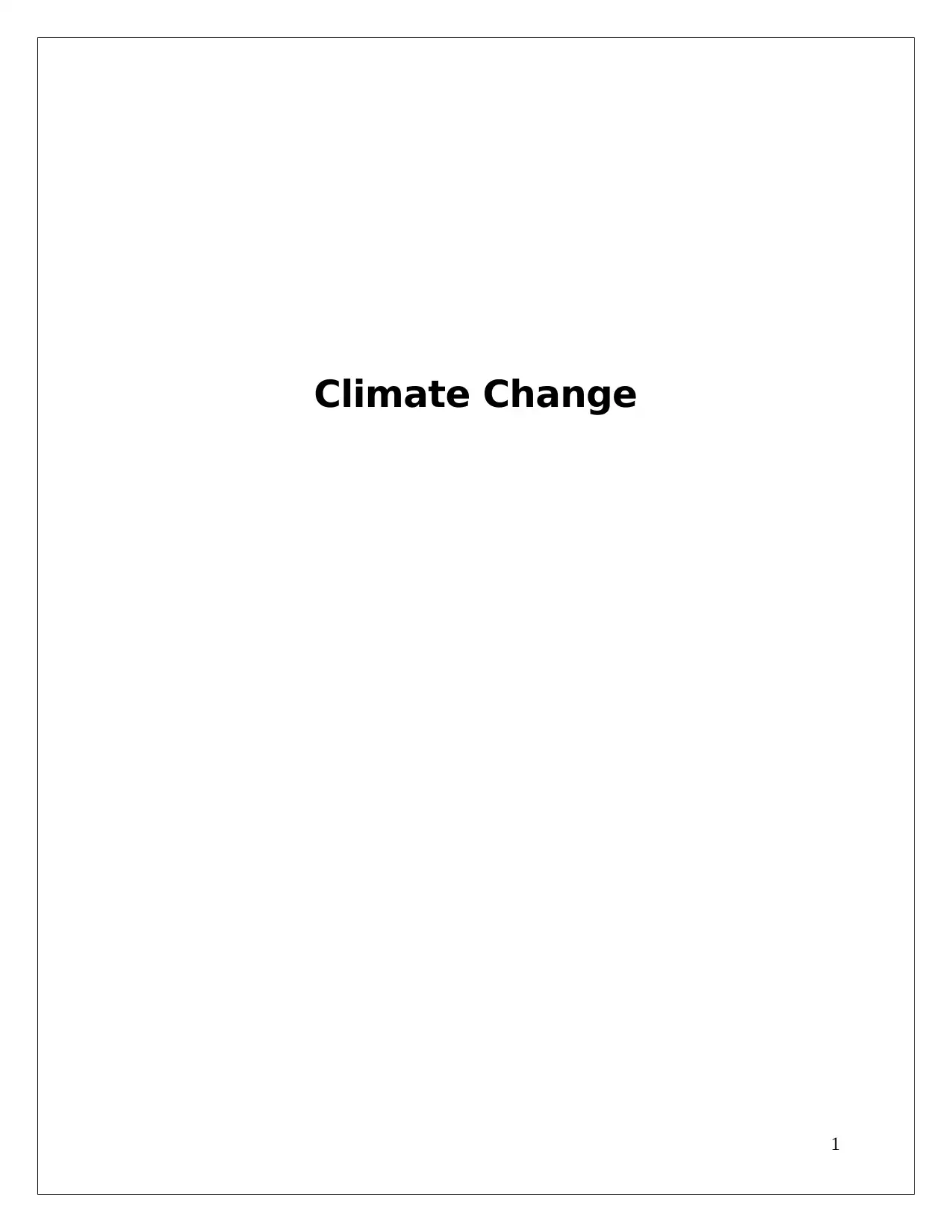
Climate Change
1
1
Paraphrase This Document
Need a fresh take? Get an instant paraphrase of this document with our AI Paraphraser
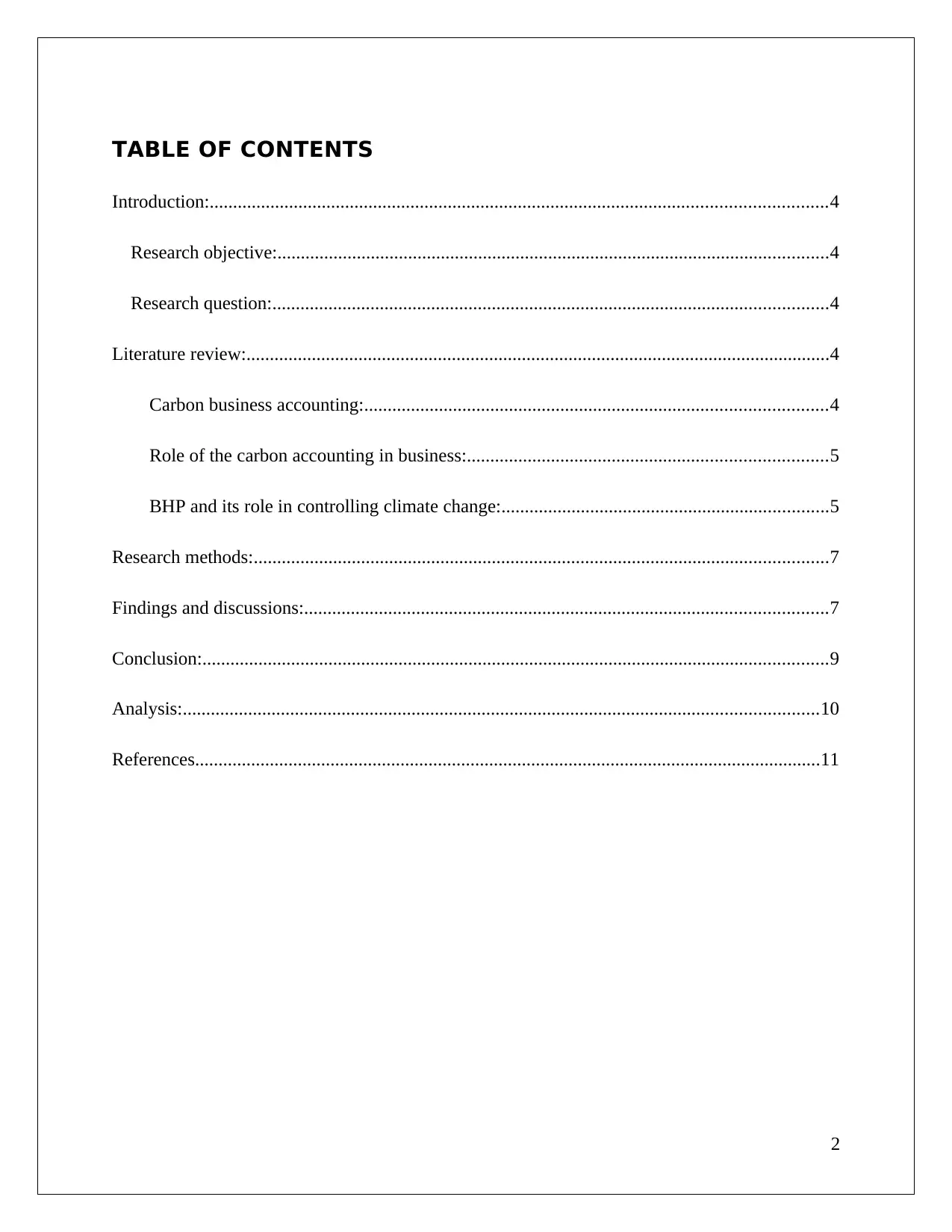
TABLE OF CONTENTS
Introduction:....................................................................................................................................4
Research objective:......................................................................................................................4
Research question:.......................................................................................................................4
Literature review:.............................................................................................................................4
Carbon business accounting:...................................................................................................4
Role of the carbon accounting in business:.............................................................................5
BHP and its role in controlling climate change:......................................................................5
Research methods:...........................................................................................................................7
Findings and discussions:................................................................................................................7
Conclusion:......................................................................................................................................9
Analysis:........................................................................................................................................10
References......................................................................................................................................11
2
Introduction:....................................................................................................................................4
Research objective:......................................................................................................................4
Research question:.......................................................................................................................4
Literature review:.............................................................................................................................4
Carbon business accounting:...................................................................................................4
Role of the carbon accounting in business:.............................................................................5
BHP and its role in controlling climate change:......................................................................5
Research methods:...........................................................................................................................7
Findings and discussions:................................................................................................................7
Conclusion:......................................................................................................................................9
Analysis:........................................................................................................................................10
References......................................................................................................................................11
2
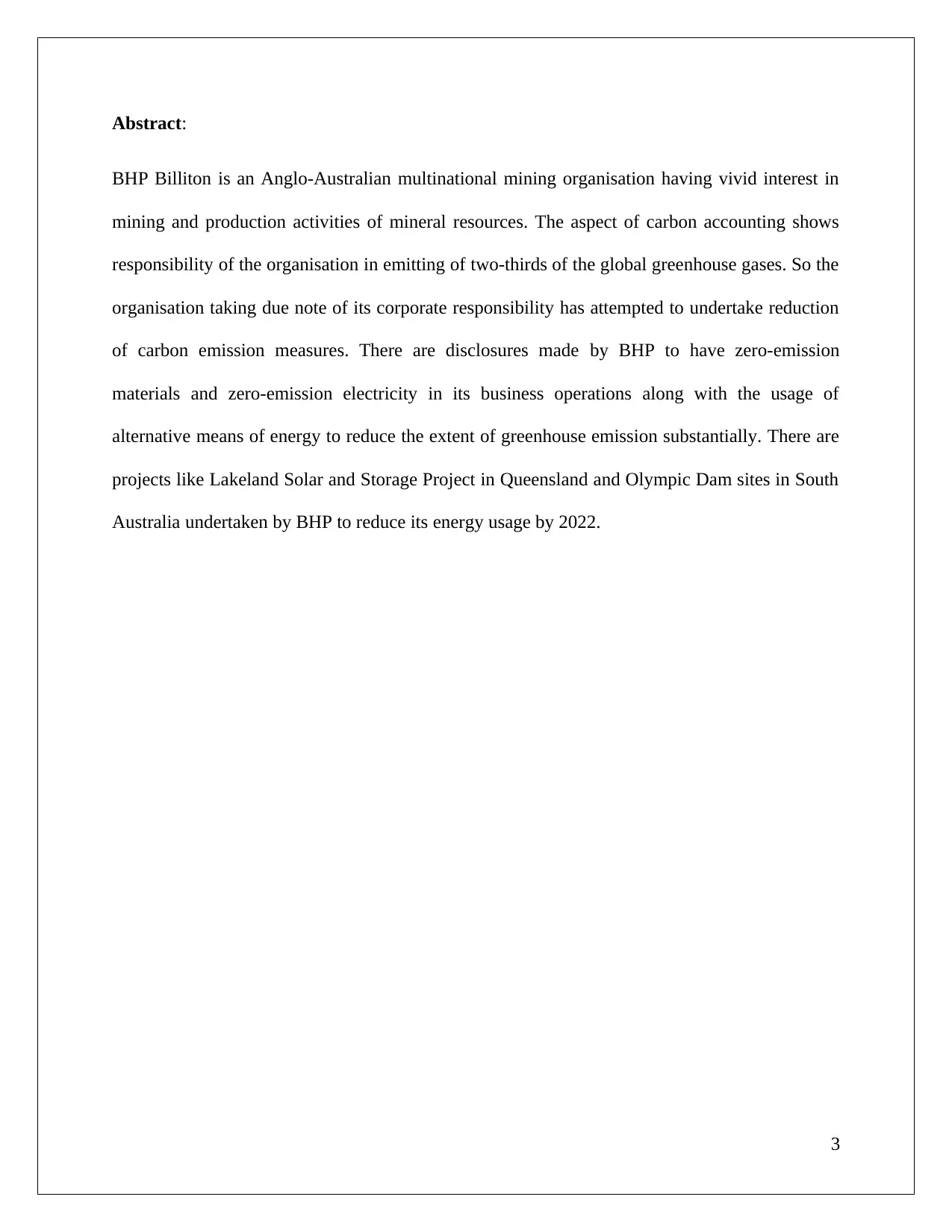
Abstract:
BHP Billiton is an Anglo-Australian multinational mining organisation having vivid interest in
mining and production activities of mineral resources. The aspect of carbon accounting shows
responsibility of the organisation in emitting of two-thirds of the global greenhouse gases. So the
organisation taking due note of its corporate responsibility has attempted to undertake reduction
of carbon emission measures. There are disclosures made by BHP to have zero-emission
materials and zero-emission electricity in its business operations along with the usage of
alternative means of energy to reduce the extent of greenhouse emission substantially. There are
projects like Lakeland Solar and Storage Project in Queensland and Olympic Dam sites in South
Australia undertaken by BHP to reduce its energy usage by 2022.
3
BHP Billiton is an Anglo-Australian multinational mining organisation having vivid interest in
mining and production activities of mineral resources. The aspect of carbon accounting shows
responsibility of the organisation in emitting of two-thirds of the global greenhouse gases. So the
organisation taking due note of its corporate responsibility has attempted to undertake reduction
of carbon emission measures. There are disclosures made by BHP to have zero-emission
materials and zero-emission electricity in its business operations along with the usage of
alternative means of energy to reduce the extent of greenhouse emission substantially. There are
projects like Lakeland Solar and Storage Project in Queensland and Olympic Dam sites in South
Australia undertaken by BHP to reduce its energy usage by 2022.
3
⊘ This is a preview!⊘
Do you want full access?
Subscribe today to unlock all pages.

Trusted by 1+ million students worldwide
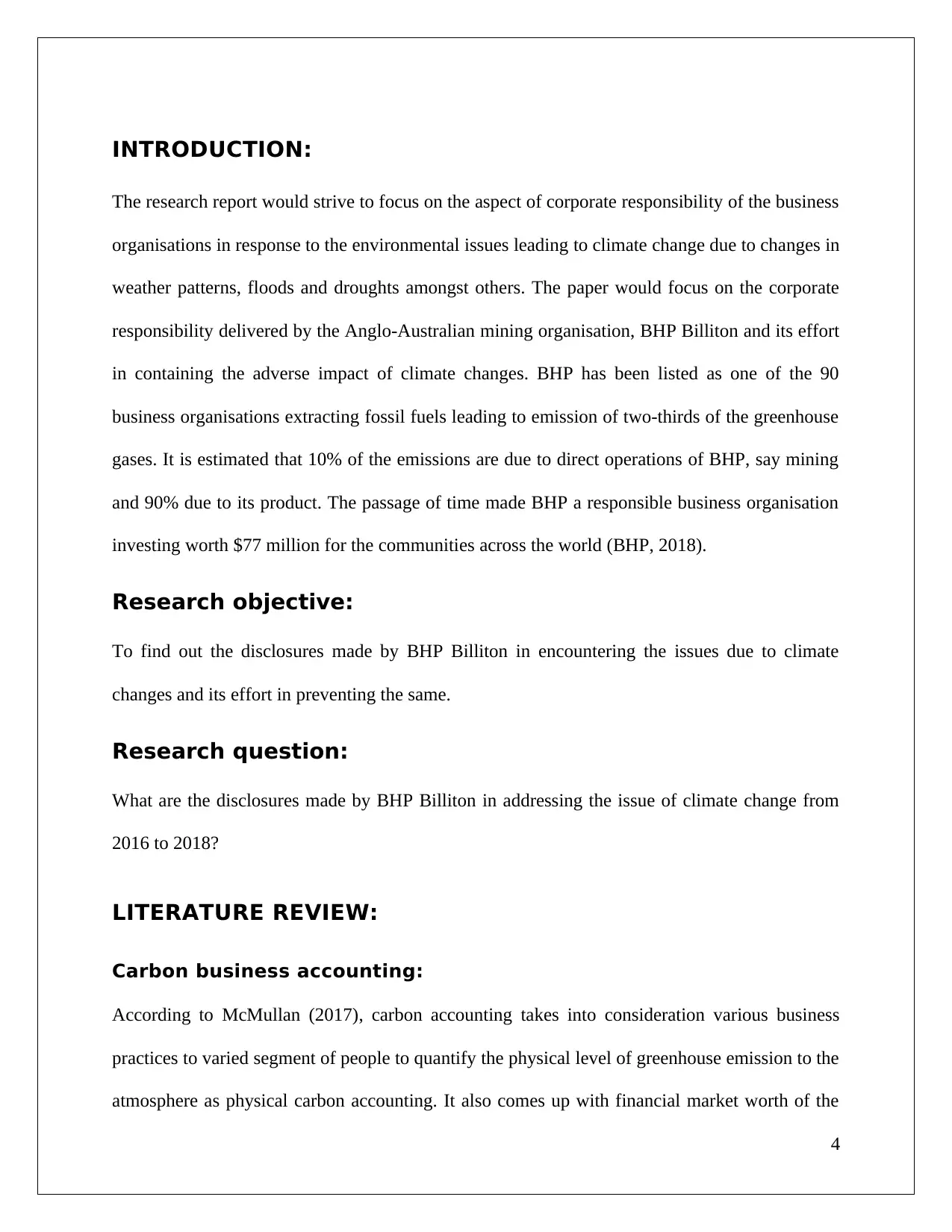
INTRODUCTION:
The research report would strive to focus on the aspect of corporate responsibility of the business
organisations in response to the environmental issues leading to climate change due to changes in
weather patterns, floods and droughts amongst others. The paper would focus on the corporate
responsibility delivered by the Anglo-Australian mining organisation, BHP Billiton and its effort
in containing the adverse impact of climate changes. BHP has been listed as one of the 90
business organisations extracting fossil fuels leading to emission of two-thirds of the greenhouse
gases. It is estimated that 10% of the emissions are due to direct operations of BHP, say mining
and 90% due to its product. The passage of time made BHP a responsible business organisation
investing worth $77 million for the communities across the world (BHP, 2018).
Research objective:
To find out the disclosures made by BHP Billiton in encountering the issues due to climate
changes and its effort in preventing the same.
Research question:
What are the disclosures made by BHP Billiton in addressing the issue of climate change from
2016 to 2018?
LITERATURE REVIEW:
Carbon business accounting:
According to McMullan (2017), carbon accounting takes into consideration various business
practices to varied segment of people to quantify the physical level of greenhouse emission to the
atmosphere as physical carbon accounting. It also comes up with financial market worth of the
4
The research report would strive to focus on the aspect of corporate responsibility of the business
organisations in response to the environmental issues leading to climate change due to changes in
weather patterns, floods and droughts amongst others. The paper would focus on the corporate
responsibility delivered by the Anglo-Australian mining organisation, BHP Billiton and its effort
in containing the adverse impact of climate changes. BHP has been listed as one of the 90
business organisations extracting fossil fuels leading to emission of two-thirds of the greenhouse
gases. It is estimated that 10% of the emissions are due to direct operations of BHP, say mining
and 90% due to its product. The passage of time made BHP a responsible business organisation
investing worth $77 million for the communities across the world (BHP, 2018).
Research objective:
To find out the disclosures made by BHP Billiton in encountering the issues due to climate
changes and its effort in preventing the same.
Research question:
What are the disclosures made by BHP Billiton in addressing the issue of climate change from
2016 to 2018?
LITERATURE REVIEW:
Carbon business accounting:
According to McMullan (2017), carbon accounting takes into consideration various business
practices to varied segment of people to quantify the physical level of greenhouse emission to the
atmosphere as physical carbon accounting. It also comes up with financial market worth of the
4
Paraphrase This Document
Need a fresh take? Get an instant paraphrase of this document with our AI Paraphraser
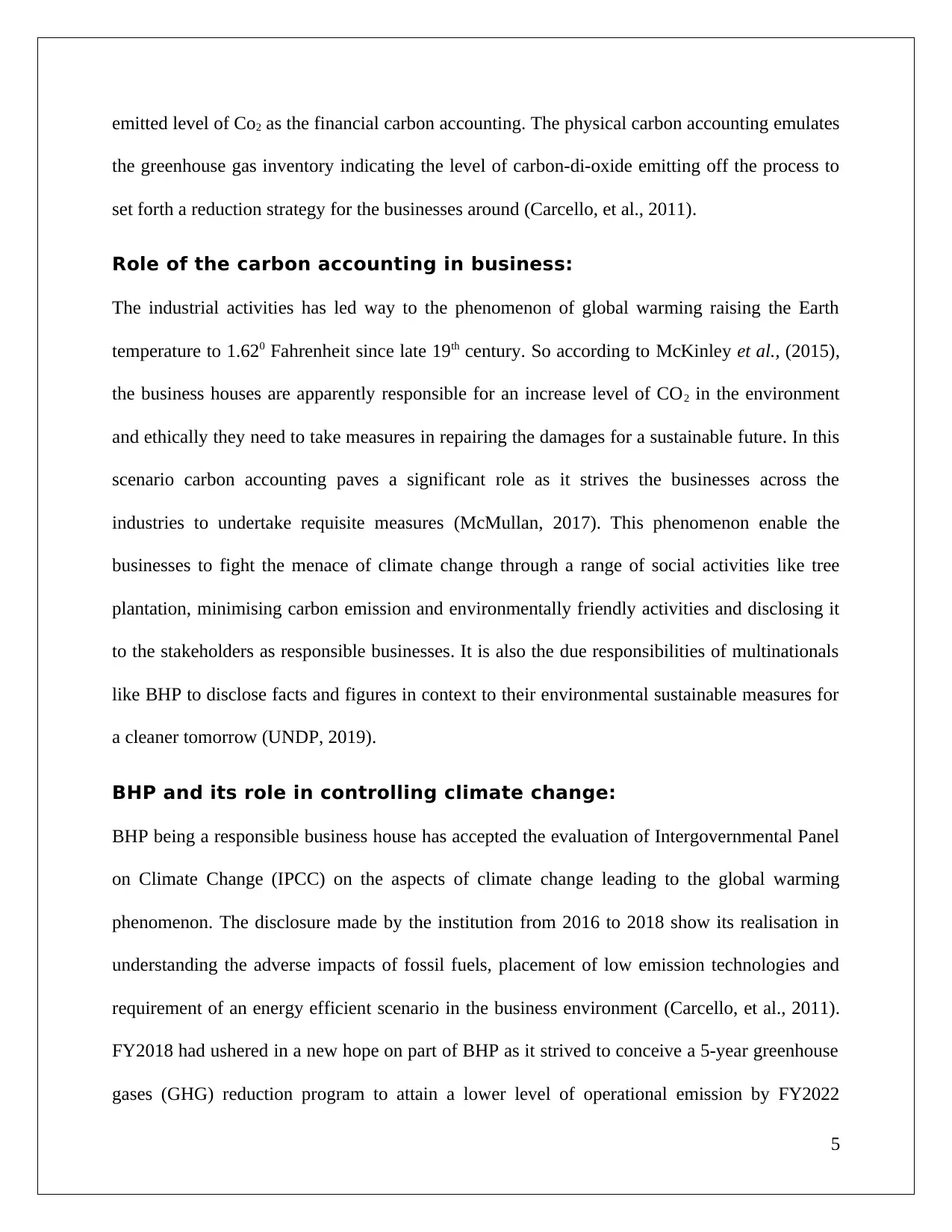
emitted level of Co2 as the financial carbon accounting. The physical carbon accounting emulates
the greenhouse gas inventory indicating the level of carbon-di-oxide emitting off the process to
set forth a reduction strategy for the businesses around (Carcello, et al., 2011).
Role of the carbon accounting in business:
The industrial activities has led way to the phenomenon of global warming raising the Earth
temperature to 1.620 Fahrenheit since late 19th century. So according to McKinley et al., (2015),
the business houses are apparently responsible for an increase level of CO2 in the environment
and ethically they need to take measures in repairing the damages for a sustainable future. In this
scenario carbon accounting paves a significant role as it strives the businesses across the
industries to undertake requisite measures (McMullan, 2017). This phenomenon enable the
businesses to fight the menace of climate change through a range of social activities like tree
plantation, minimising carbon emission and environmentally friendly activities and disclosing it
to the stakeholders as responsible businesses. It is also the due responsibilities of multinationals
like BHP to disclose facts and figures in context to their environmental sustainable measures for
a cleaner tomorrow (UNDP, 2019).
BHP and its role in controlling climate change:
BHP being a responsible business house has accepted the evaluation of Intergovernmental Panel
on Climate Change (IPCC) on the aspects of climate change leading to the global warming
phenomenon. The disclosure made by the institution from 2016 to 2018 show its realisation in
understanding the adverse impacts of fossil fuels, placement of low emission technologies and
requirement of an energy efficient scenario in the business environment (Carcello, et al., 2011).
FY2018 had ushered in a new hope on part of BHP as it strived to conceive a 5-year greenhouse
gases (GHG) reduction program to attain a lower level of operational emission by FY2022
5
the greenhouse gas inventory indicating the level of carbon-di-oxide emitting off the process to
set forth a reduction strategy for the businesses around (Carcello, et al., 2011).
Role of the carbon accounting in business:
The industrial activities has led way to the phenomenon of global warming raising the Earth
temperature to 1.620 Fahrenheit since late 19th century. So according to McKinley et al., (2015),
the business houses are apparently responsible for an increase level of CO2 in the environment
and ethically they need to take measures in repairing the damages for a sustainable future. In this
scenario carbon accounting paves a significant role as it strives the businesses across the
industries to undertake requisite measures (McMullan, 2017). This phenomenon enable the
businesses to fight the menace of climate change through a range of social activities like tree
plantation, minimising carbon emission and environmentally friendly activities and disclosing it
to the stakeholders as responsible businesses. It is also the due responsibilities of multinationals
like BHP to disclose facts and figures in context to their environmental sustainable measures for
a cleaner tomorrow (UNDP, 2019).
BHP and its role in controlling climate change:
BHP being a responsible business house has accepted the evaluation of Intergovernmental Panel
on Climate Change (IPCC) on the aspects of climate change leading to the global warming
phenomenon. The disclosure made by the institution from 2016 to 2018 show its realisation in
understanding the adverse impacts of fossil fuels, placement of low emission technologies and
requirement of an energy efficient scenario in the business environment (Carcello, et al., 2011).
FY2018 had ushered in a new hope on part of BHP as it strived to conceive a 5-year greenhouse
gases (GHG) reduction program to attain a lower level of operational emission by FY2022
5
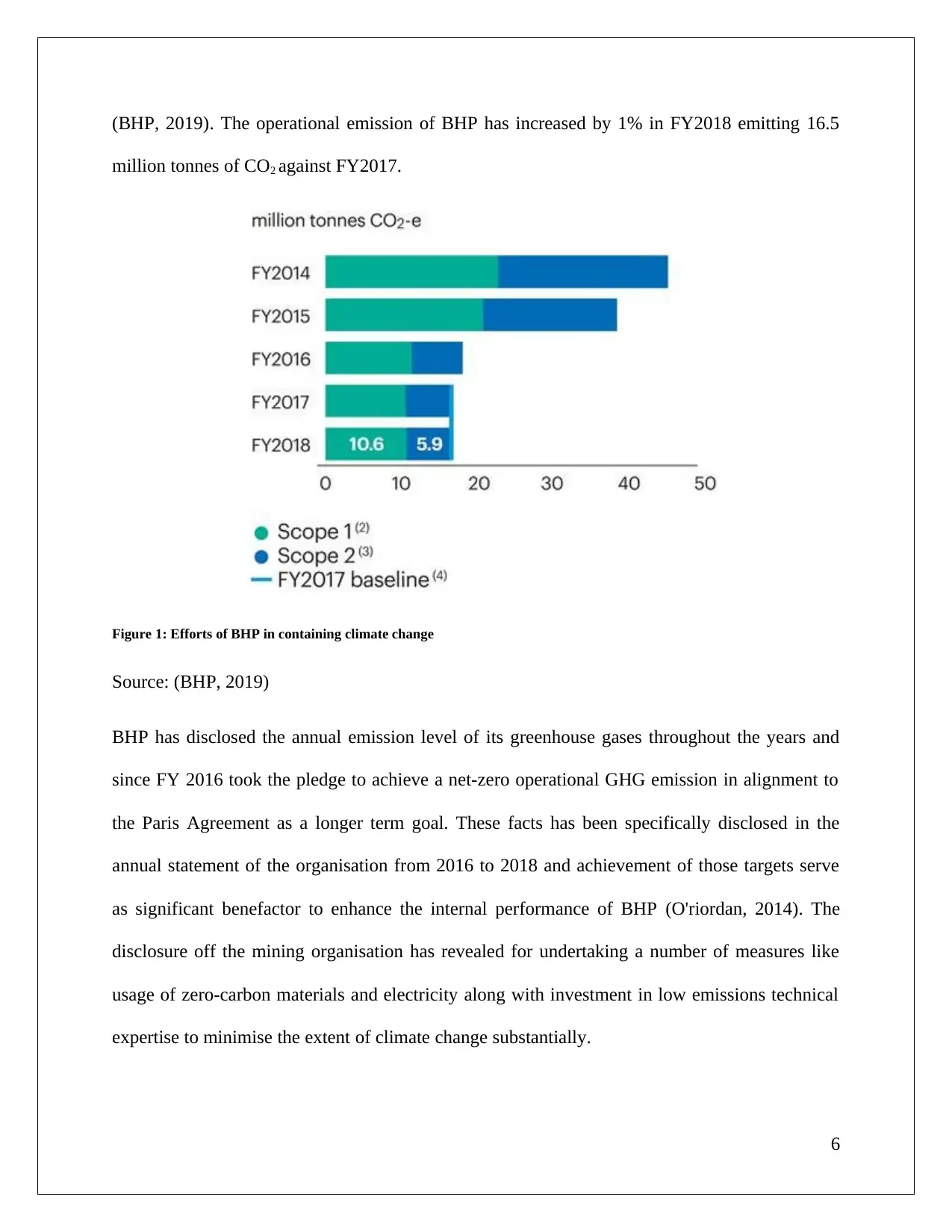
(BHP, 2019). The operational emission of BHP has increased by 1% in FY2018 emitting 16.5
million tonnes of CO2 against FY2017.
Figure 1: Efforts of BHP in containing climate change
Source: (BHP, 2019)
BHP has disclosed the annual emission level of its greenhouse gases throughout the years and
since FY 2016 took the pledge to achieve a net-zero operational GHG emission in alignment to
the Paris Agreement as a longer term goal. These facts has been specifically disclosed in the
annual statement of the organisation from 2016 to 2018 and achievement of those targets serve
as significant benefactor to enhance the internal performance of BHP (O'riordan, 2014). The
disclosure off the mining organisation has revealed for undertaking a number of measures like
usage of zero-carbon materials and electricity along with investment in low emissions technical
expertise to minimise the extent of climate change substantially.
6
million tonnes of CO2 against FY2017.
Figure 1: Efforts of BHP in containing climate change
Source: (BHP, 2019)
BHP has disclosed the annual emission level of its greenhouse gases throughout the years and
since FY 2016 took the pledge to achieve a net-zero operational GHG emission in alignment to
the Paris Agreement as a longer term goal. These facts has been specifically disclosed in the
annual statement of the organisation from 2016 to 2018 and achievement of those targets serve
as significant benefactor to enhance the internal performance of BHP (O'riordan, 2014). The
disclosure off the mining organisation has revealed for undertaking a number of measures like
usage of zero-carbon materials and electricity along with investment in low emissions technical
expertise to minimise the extent of climate change substantially.
6
⊘ This is a preview!⊘
Do you want full access?
Subscribe today to unlock all pages.

Trusted by 1+ million students worldwide
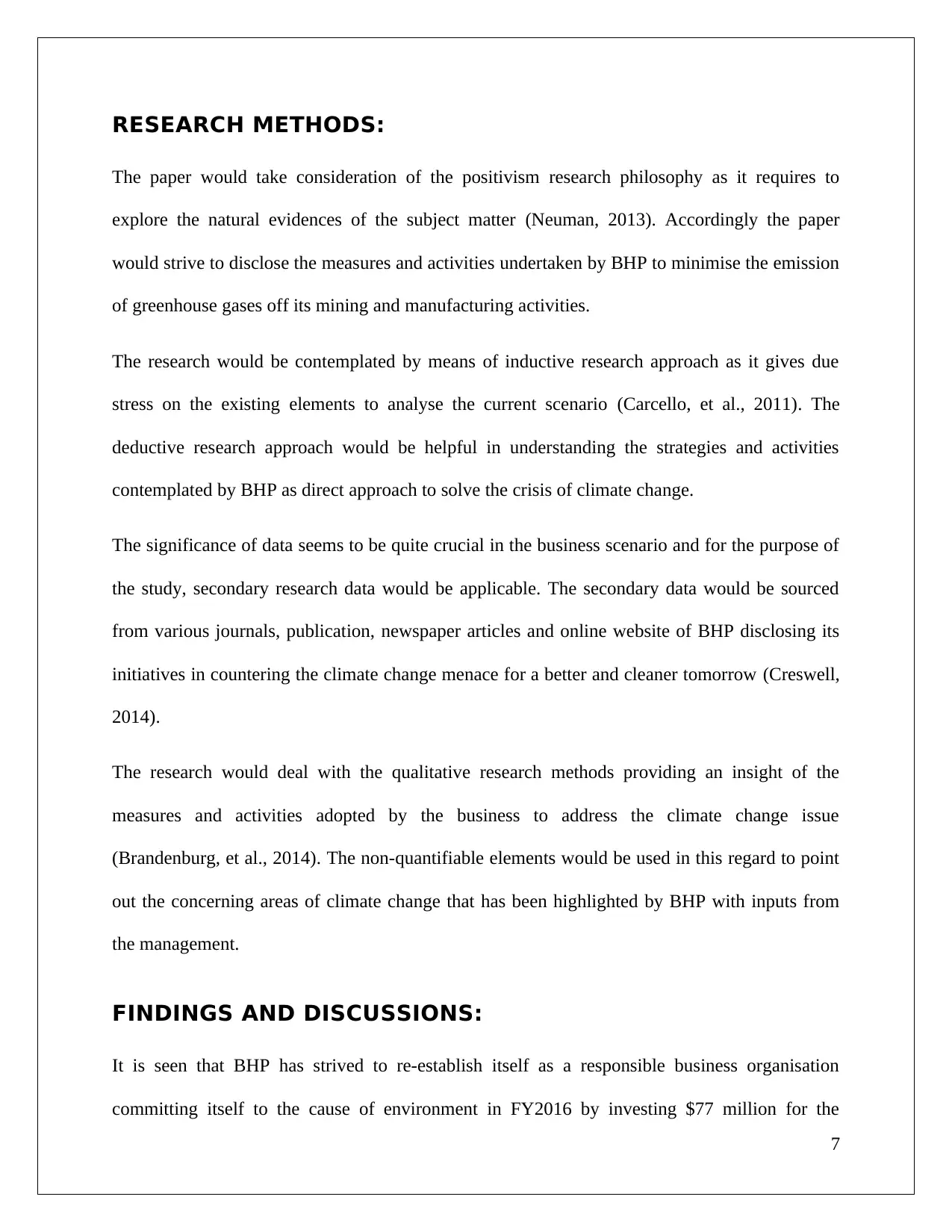
RESEARCH METHODS:
The paper would take consideration of the positivism research philosophy as it requires to
explore the natural evidences of the subject matter (Neuman, 2013). Accordingly the paper
would strive to disclose the measures and activities undertaken by BHP to minimise the emission
of greenhouse gases off its mining and manufacturing activities.
The research would be contemplated by means of inductive research approach as it gives due
stress on the existing elements to analyse the current scenario (Carcello, et al., 2011). The
deductive research approach would be helpful in understanding the strategies and activities
contemplated by BHP as direct approach to solve the crisis of climate change.
The significance of data seems to be quite crucial in the business scenario and for the purpose of
the study, secondary research data would be applicable. The secondary data would be sourced
from various journals, publication, newspaper articles and online website of BHP disclosing its
initiatives in countering the climate change menace for a better and cleaner tomorrow (Creswell,
2014).
The research would deal with the qualitative research methods providing an insight of the
measures and activities adopted by the business to address the climate change issue
(Brandenburg, et al., 2014). The non-quantifiable elements would be used in this regard to point
out the concerning areas of climate change that has been highlighted by BHP with inputs from
the management.
FINDINGS AND DISCUSSIONS:
It is seen that BHP has strived to re-establish itself as a responsible business organisation
committing itself to the cause of environment in FY2016 by investing $77 million for the
7
The paper would take consideration of the positivism research philosophy as it requires to
explore the natural evidences of the subject matter (Neuman, 2013). Accordingly the paper
would strive to disclose the measures and activities undertaken by BHP to minimise the emission
of greenhouse gases off its mining and manufacturing activities.
The research would be contemplated by means of inductive research approach as it gives due
stress on the existing elements to analyse the current scenario (Carcello, et al., 2011). The
deductive research approach would be helpful in understanding the strategies and activities
contemplated by BHP as direct approach to solve the crisis of climate change.
The significance of data seems to be quite crucial in the business scenario and for the purpose of
the study, secondary research data would be applicable. The secondary data would be sourced
from various journals, publication, newspaper articles and online website of BHP disclosing its
initiatives in countering the climate change menace for a better and cleaner tomorrow (Creswell,
2014).
The research would deal with the qualitative research methods providing an insight of the
measures and activities adopted by the business to address the climate change issue
(Brandenburg, et al., 2014). The non-quantifiable elements would be used in this regard to point
out the concerning areas of climate change that has been highlighted by BHP with inputs from
the management.
FINDINGS AND DISCUSSIONS:
It is seen that BHP has strived to re-establish itself as a responsible business organisation
committing itself to the cause of environment in FY2016 by investing $77 million for the
7
Paraphrase This Document
Need a fresh take? Get an instant paraphrase of this document with our AI Paraphraser
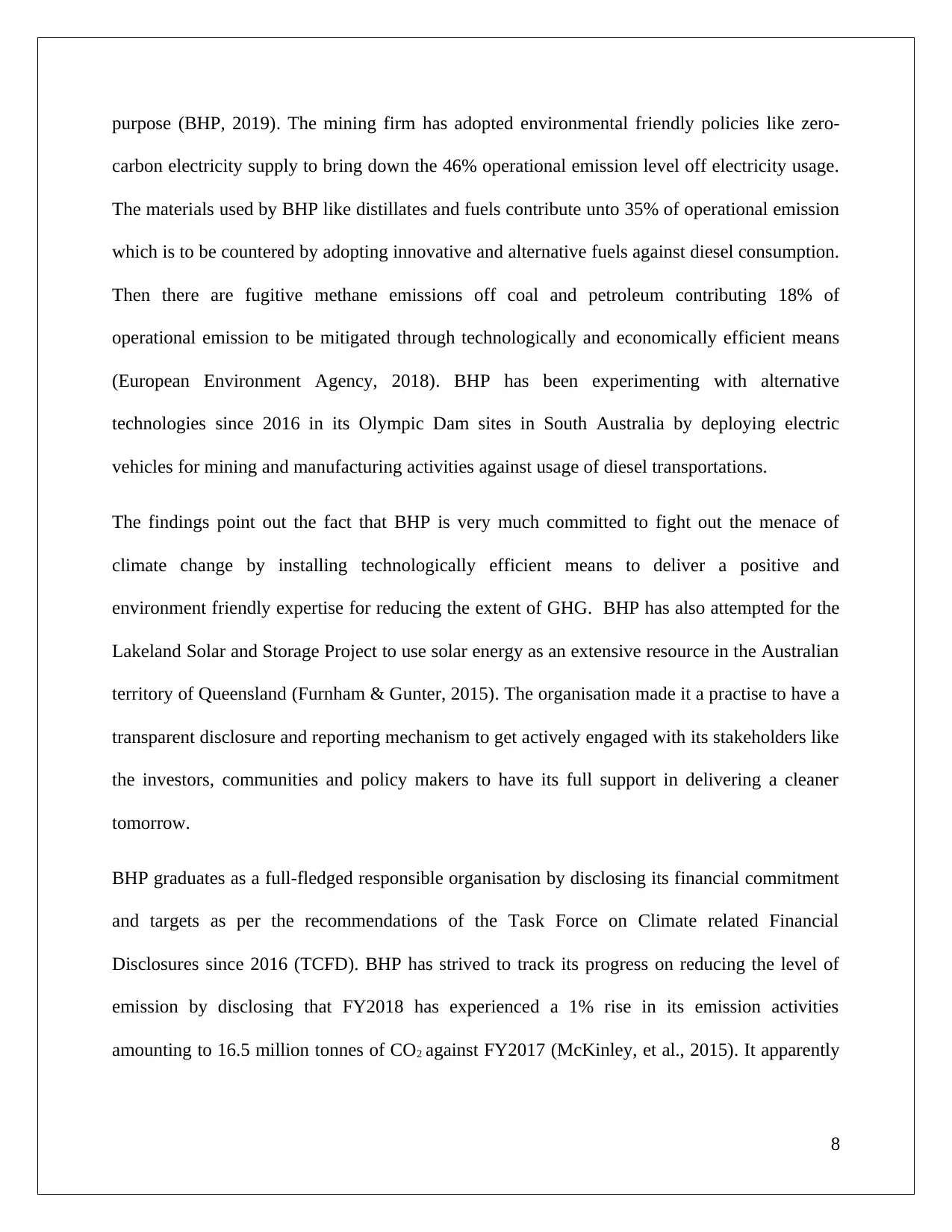
purpose (BHP, 2019). The mining firm has adopted environmental friendly policies like zero-
carbon electricity supply to bring down the 46% operational emission level off electricity usage.
The materials used by BHP like distillates and fuels contribute unto 35% of operational emission
which is to be countered by adopting innovative and alternative fuels against diesel consumption.
Then there are fugitive methane emissions off coal and petroleum contributing 18% of
operational emission to be mitigated through technologically and economically efficient means
(European Environment Agency, 2018). BHP has been experimenting with alternative
technologies since 2016 in its Olympic Dam sites in South Australia by deploying electric
vehicles for mining and manufacturing activities against usage of diesel transportations.
The findings point out the fact that BHP is very much committed to fight out the menace of
climate change by installing technologically efficient means to deliver a positive and
environment friendly expertise for reducing the extent of GHG. BHP has also attempted for the
Lakeland Solar and Storage Project to use solar energy as an extensive resource in the Australian
territory of Queensland (Furnham & Gunter, 2015). The organisation made it a practise to have a
transparent disclosure and reporting mechanism to get actively engaged with its stakeholders like
the investors, communities and policy makers to have its full support in delivering a cleaner
tomorrow.
BHP graduates as a full-fledged responsible organisation by disclosing its financial commitment
and targets as per the recommendations of the Task Force on Climate related Financial
Disclosures since 2016 (TCFD). BHP has strived to track its progress on reducing the level of
emission by disclosing that FY2018 has experienced a 1% rise in its emission activities
amounting to 16.5 million tonnes of CO2 against FY2017 (McKinley, et al., 2015). It apparently
8
carbon electricity supply to bring down the 46% operational emission level off electricity usage.
The materials used by BHP like distillates and fuels contribute unto 35% of operational emission
which is to be countered by adopting innovative and alternative fuels against diesel consumption.
Then there are fugitive methane emissions off coal and petroleum contributing 18% of
operational emission to be mitigated through technologically and economically efficient means
(European Environment Agency, 2018). BHP has been experimenting with alternative
technologies since 2016 in its Olympic Dam sites in South Australia by deploying electric
vehicles for mining and manufacturing activities against usage of diesel transportations.
The findings point out the fact that BHP is very much committed to fight out the menace of
climate change by installing technologically efficient means to deliver a positive and
environment friendly expertise for reducing the extent of GHG. BHP has also attempted for the
Lakeland Solar and Storage Project to use solar energy as an extensive resource in the Australian
territory of Queensland (Furnham & Gunter, 2015). The organisation made it a practise to have a
transparent disclosure and reporting mechanism to get actively engaged with its stakeholders like
the investors, communities and policy makers to have its full support in delivering a cleaner
tomorrow.
BHP graduates as a full-fledged responsible organisation by disclosing its financial commitment
and targets as per the recommendations of the Task Force on Climate related Financial
Disclosures since 2016 (TCFD). BHP has strived to track its progress on reducing the level of
emission by disclosing that FY2018 has experienced a 1% rise in its emission activities
amounting to 16.5 million tonnes of CO2 against FY2017 (McKinley, et al., 2015). It apparently
8
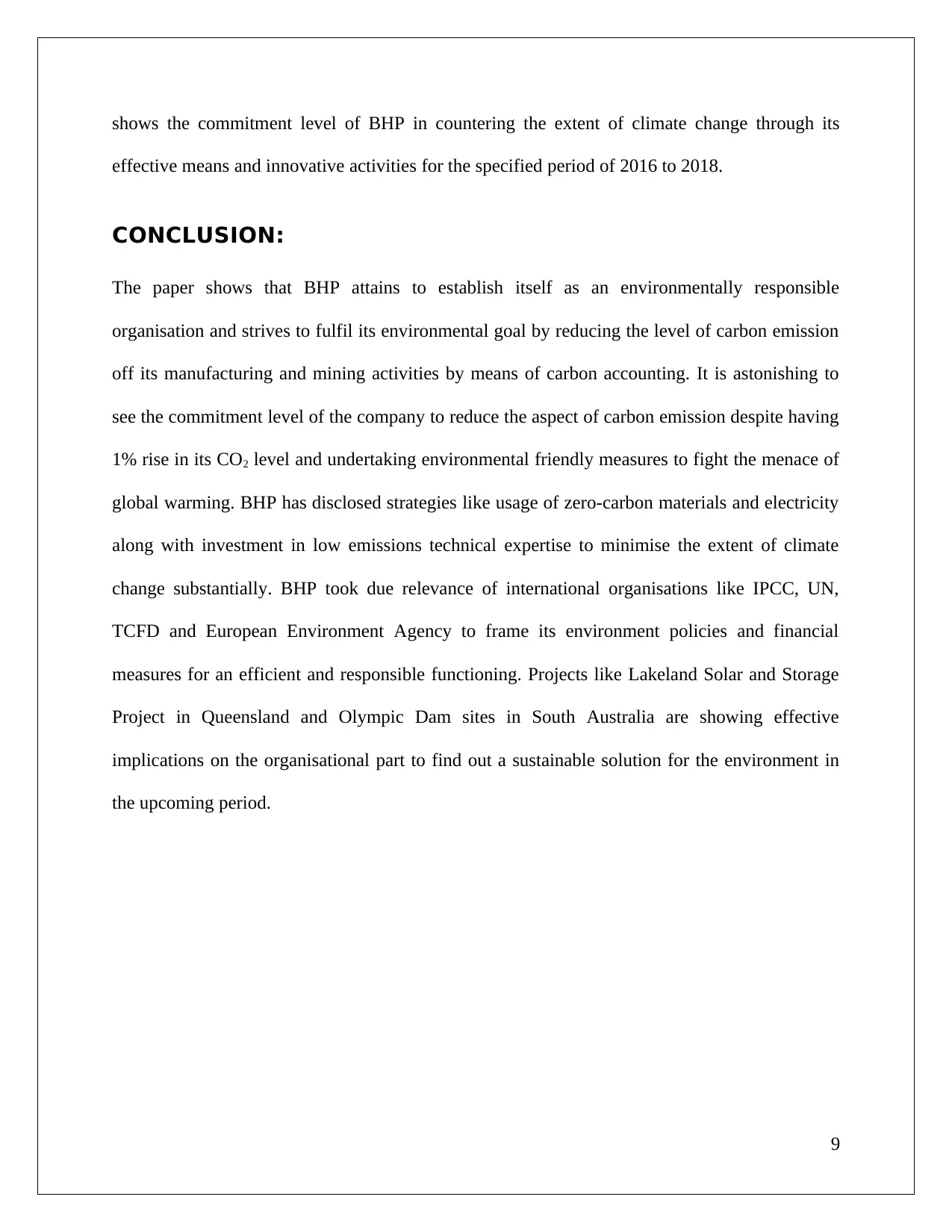
shows the commitment level of BHP in countering the extent of climate change through its
effective means and innovative activities for the specified period of 2016 to 2018.
CONCLUSION:
The paper shows that BHP attains to establish itself as an environmentally responsible
organisation and strives to fulfil its environmental goal by reducing the level of carbon emission
off its manufacturing and mining activities by means of carbon accounting. It is astonishing to
see the commitment level of the company to reduce the aspect of carbon emission despite having
1% rise in its CO2 level and undertaking environmental friendly measures to fight the menace of
global warming. BHP has disclosed strategies like usage of zero-carbon materials and electricity
along with investment in low emissions technical expertise to minimise the extent of climate
change substantially. BHP took due relevance of international organisations like IPCC, UN,
TCFD and European Environment Agency to frame its environment policies and financial
measures for an efficient and responsible functioning. Projects like Lakeland Solar and Storage
Project in Queensland and Olympic Dam sites in South Australia are showing effective
implications on the organisational part to find out a sustainable solution for the environment in
the upcoming period.
9
effective means and innovative activities for the specified period of 2016 to 2018.
CONCLUSION:
The paper shows that BHP attains to establish itself as an environmentally responsible
organisation and strives to fulfil its environmental goal by reducing the level of carbon emission
off its manufacturing and mining activities by means of carbon accounting. It is astonishing to
see the commitment level of the company to reduce the aspect of carbon emission despite having
1% rise in its CO2 level and undertaking environmental friendly measures to fight the menace of
global warming. BHP has disclosed strategies like usage of zero-carbon materials and electricity
along with investment in low emissions technical expertise to minimise the extent of climate
change substantially. BHP took due relevance of international organisations like IPCC, UN,
TCFD and European Environment Agency to frame its environment policies and financial
measures for an efficient and responsible functioning. Projects like Lakeland Solar and Storage
Project in Queensland and Olympic Dam sites in South Australia are showing effective
implications on the organisational part to find out a sustainable solution for the environment in
the upcoming period.
9
⊘ This is a preview!⊘
Do you want full access?
Subscribe today to unlock all pages.

Trusted by 1+ million students worldwide
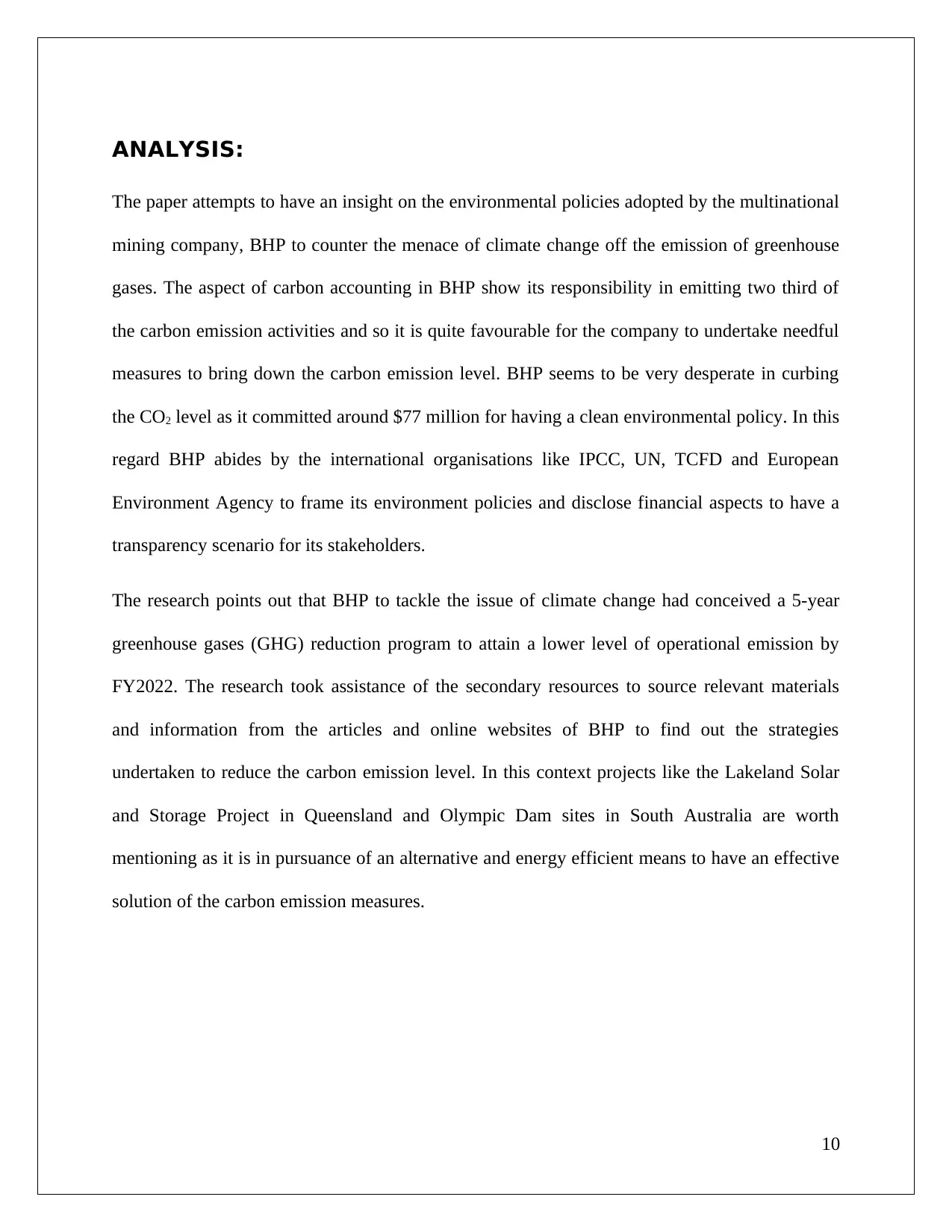
ANALYSIS:
The paper attempts to have an insight on the environmental policies adopted by the multinational
mining company, BHP to counter the menace of climate change off the emission of greenhouse
gases. The aspect of carbon accounting in BHP show its responsibility in emitting two third of
the carbon emission activities and so it is quite favourable for the company to undertake needful
measures to bring down the carbon emission level. BHP seems to be very desperate in curbing
the CO2 level as it committed around $77 million for having a clean environmental policy. In this
regard BHP abides by the international organisations like IPCC, UN, TCFD and European
Environment Agency to frame its environment policies and disclose financial aspects to have a
transparency scenario for its stakeholders.
The research points out that BHP to tackle the issue of climate change had conceived a 5-year
greenhouse gases (GHG) reduction program to attain a lower level of operational emission by
FY2022. The research took assistance of the secondary resources to source relevant materials
and information from the articles and online websites of BHP to find out the strategies
undertaken to reduce the carbon emission level. In this context projects like the Lakeland Solar
and Storage Project in Queensland and Olympic Dam sites in South Australia are worth
mentioning as it is in pursuance of an alternative and energy efficient means to have an effective
solution of the carbon emission measures.
10
The paper attempts to have an insight on the environmental policies adopted by the multinational
mining company, BHP to counter the menace of climate change off the emission of greenhouse
gases. The aspect of carbon accounting in BHP show its responsibility in emitting two third of
the carbon emission activities and so it is quite favourable for the company to undertake needful
measures to bring down the carbon emission level. BHP seems to be very desperate in curbing
the CO2 level as it committed around $77 million for having a clean environmental policy. In this
regard BHP abides by the international organisations like IPCC, UN, TCFD and European
Environment Agency to frame its environment policies and disclose financial aspects to have a
transparency scenario for its stakeholders.
The research points out that BHP to tackle the issue of climate change had conceived a 5-year
greenhouse gases (GHG) reduction program to attain a lower level of operational emission by
FY2022. The research took assistance of the secondary resources to source relevant materials
and information from the articles and online websites of BHP to find out the strategies
undertaken to reduce the carbon emission level. In this context projects like the Lakeland Solar
and Storage Project in Queensland and Olympic Dam sites in South Australia are worth
mentioning as it is in pursuance of an alternative and energy efficient means to have an effective
solution of the carbon emission measures.
10
Paraphrase This Document
Need a fresh take? Get an instant paraphrase of this document with our AI Paraphraser
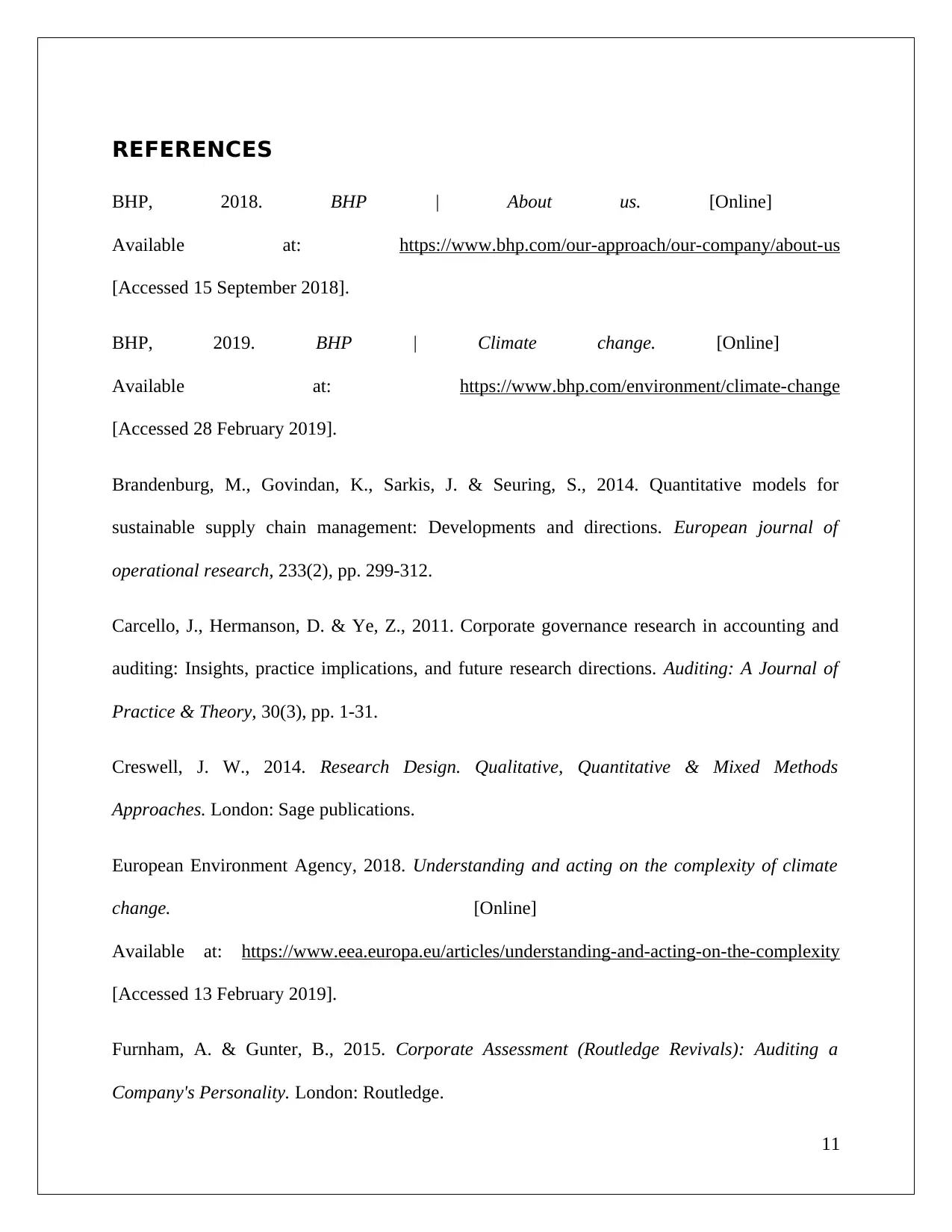
REFERENCES
BHP, 2018. BHP | About us. [Online]
Available at: https://www.bhp.com/our-approach/our-company/about-us
[Accessed 15 September 2018].
BHP, 2019. BHP | Climate change. [Online]
Available at: https://www.bhp.com/environment/climate-change
[Accessed 28 February 2019].
Brandenburg, M., Govindan, K., Sarkis, J. & Seuring, S., 2014. Quantitative models for
sustainable supply chain management: Developments and directions. European journal of
operational research, 233(2), pp. 299-312.
Carcello, J., Hermanson, D. & Ye, Z., 2011. Corporate governance research in accounting and
auditing: Insights, practice implications, and future research directions. Auditing: A Journal of
Practice & Theory, 30(3), pp. 1-31.
Creswell, J. W., 2014. Research Design. Qualitative, Quantitative & Mixed Methods
Approaches. London: Sage publications.
European Environment Agency, 2018. Understanding and acting on the complexity of climate
change. [Online]
Available at: https://www.eea.europa.eu/articles/understanding-and-acting-on-the-complexity
[Accessed 13 February 2019].
Furnham, A. & Gunter, B., 2015. Corporate Assessment (Routledge Revivals): Auditing a
Company's Personality. London: Routledge.
11
BHP, 2018. BHP | About us. [Online]
Available at: https://www.bhp.com/our-approach/our-company/about-us
[Accessed 15 September 2018].
BHP, 2019. BHP | Climate change. [Online]
Available at: https://www.bhp.com/environment/climate-change
[Accessed 28 February 2019].
Brandenburg, M., Govindan, K., Sarkis, J. & Seuring, S., 2014. Quantitative models for
sustainable supply chain management: Developments and directions. European journal of
operational research, 233(2), pp. 299-312.
Carcello, J., Hermanson, D. & Ye, Z., 2011. Corporate governance research in accounting and
auditing: Insights, practice implications, and future research directions. Auditing: A Journal of
Practice & Theory, 30(3), pp. 1-31.
Creswell, J. W., 2014. Research Design. Qualitative, Quantitative & Mixed Methods
Approaches. London: Sage publications.
European Environment Agency, 2018. Understanding and acting on the complexity of climate
change. [Online]
Available at: https://www.eea.europa.eu/articles/understanding-and-acting-on-the-complexity
[Accessed 13 February 2019].
Furnham, A. & Gunter, B., 2015. Corporate Assessment (Routledge Revivals): Auditing a
Company's Personality. London: Routledge.
11
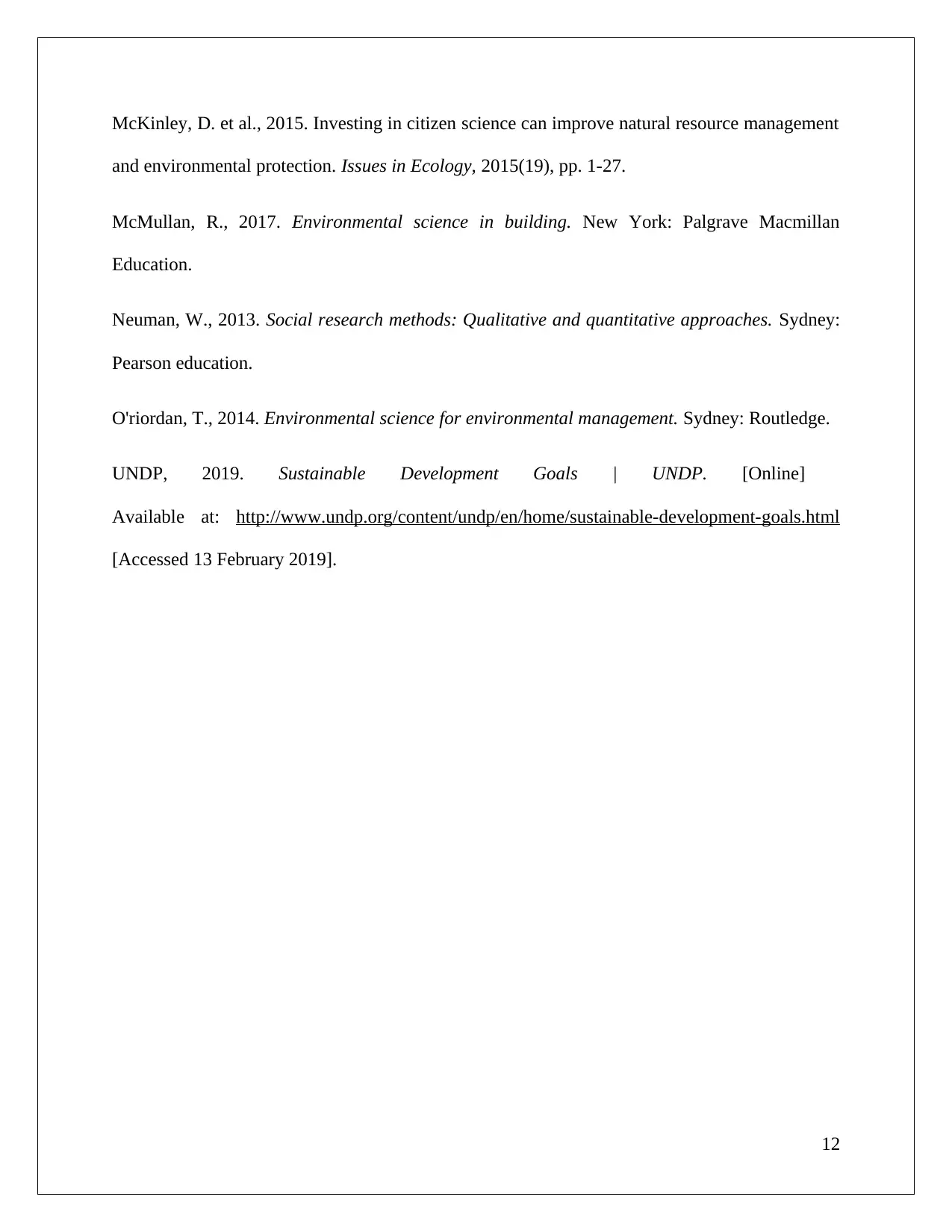
McKinley, D. et al., 2015. Investing in citizen science can improve natural resource management
and environmental protection. Issues in Ecology, 2015(19), pp. 1-27.
McMullan, R., 2017. Environmental science in building. New York: Palgrave Macmillan
Education.
Neuman, W., 2013. Social research methods: Qualitative and quantitative approaches. Sydney:
Pearson education.
O'riordan, T., 2014. Environmental science for environmental management. Sydney: Routledge.
UNDP, 2019. Sustainable Development Goals | UNDP. [Online]
Available at: http://www.undp.org/content/undp/en/home/sustainable-development-goals.html
[Accessed 13 February 2019].
12
and environmental protection. Issues in Ecology, 2015(19), pp. 1-27.
McMullan, R., 2017. Environmental science in building. New York: Palgrave Macmillan
Education.
Neuman, W., 2013. Social research methods: Qualitative and quantitative approaches. Sydney:
Pearson education.
O'riordan, T., 2014. Environmental science for environmental management. Sydney: Routledge.
UNDP, 2019. Sustainable Development Goals | UNDP. [Online]
Available at: http://www.undp.org/content/undp/en/home/sustainable-development-goals.html
[Accessed 13 February 2019].
12
⊘ This is a preview!⊘
Do you want full access?
Subscribe today to unlock all pages.

Trusted by 1+ million students worldwide
1 out of 12
Related Documents
Your All-in-One AI-Powered Toolkit for Academic Success.
+13062052269
info@desklib.com
Available 24*7 on WhatsApp / Email
![[object Object]](/_next/static/media/star-bottom.7253800d.svg)
Unlock your academic potential
Copyright © 2020–2025 A2Z Services. All Rights Reserved. Developed and managed by ZUCOL.





